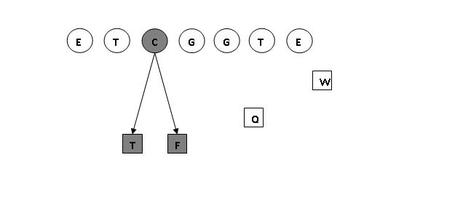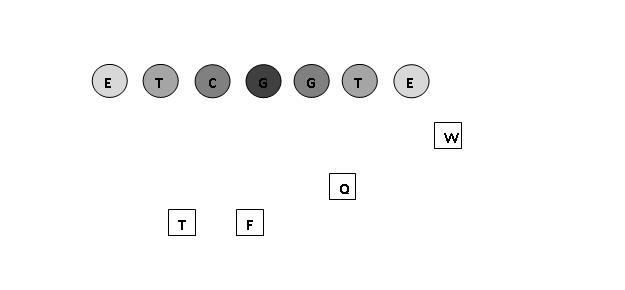by hooper on Jul 29, 2008 6:00 AM CDT in Tennessee Volunteer Football
This is the second part in the series on the UT offense and the Single Wing. The first part may be read here.
In the previous post in this series, I noted that Clawson experimented with the Single Wing formation in the Spring scrimmage game. Most of the previous post was spent explaining what the Single Wing looks like, and a few of the advantages that the formation gave to the offense. Here, I will take a look at the real action: what happens once the ball is snapped?
Prior to the snap, the Single Wing simply looks like a run-heavy formation - something that may be used in goal-line situations, perhaps. The classic Single Wing has no wide receivers, 4 players in the backfield, and 7 blockers. But the fundamental theory behind Single Wing football is quite different from a pro-set offense, beginning with the instant that the center begins to move the football backward. At that point, football begins to look a little bit less like today's NFL game and a little bit more like a rugby match.
So let's take a look at the snap...
This is the second part in the series on the UT offense and the Single Wing. The first part may be read here.
In the previous post in this series, I noted that Clawson experimented with the Single Wing formation in the Spring scrimmage game. Most of the previous post was spent explaining what the Single Wing looks like, and a few of the advantages that the formation gave to the offense. Here, I will take a look at the real action: what happens once the ball is snapped?
Prior to the snap, the Single Wing simply looks like a run-heavy formation - something that may be used in goal-line situations, perhaps. The classic Single Wing has no wide receivers, 4 players in the backfield, and 7 blockers. But the fundamental theory behind Single Wing football is quite different from a pro-set offense, beginning with the instant that the center begins to move the football backward. At that point, football begins to look a little bit less like today's NFL game and a little bit more like a rugby match.
So let's take a look at the snap...
 FIGURE 3 - THE SNAP
FIGURE 3 - THE SNAPWhen the Single Wing was created around the turn of the century, the direct snap was not legal (e.g. today's QB-under-center snap). Instead, the ball had to be tossed back to a ball carrier in a manner similar to the modern shotgun snap. (Earlier, during football's very early years, the ball was put into play rugby-style, by being sort-of kicked back by the center. The American changes instituted the handling of the ball by the center, but the distance requirement remained and the ball was put into play in a shotgun-style snap for a long time.)
Here, the center snaps to either ‘back as the play dictates. However, it's not just a matter of snapping to one of two slightly skewed positions; the ball was usually snapped to some position in front of the receiving ‘back in their line of path. This gave the initial ball handler an extra step on the play but required much of the center. Aside from the usual snap-then-get-your-head-up-and-block skill, the center had to have sure hands and be full of self-confidence. (Hmm... do we know where a center with those traits might be found?)
But why move the center to the side? Couldn't he snap the ball like that from his now-customary position? Certainly. Actually, there are balanced-line Single Wing formations; the Single Wing displayed in the O&W game had a balanced line, in fact. But take a look at what is gained by moving the center:

FIGURE 4 - A DIFFERENT LOOK AT THE LINE
Take a look at the line -- not in terms of player position titles, but from the inside out. Remember that the center, because of his task of snapping the ball, is always about a half step behind the rest of the linemen in getting out of his stance. In modern formations, that means that the hinge of nearly every blocking scheme lags the rest of the line. In the Single Wing, that lag has been moved slightly to one side. If you consider the ends as linemen (which is what they were, historically) then you have the awesome result of having four linemen in a row that can all move in true unison at the snap of the ball. Take a second look at that in the above formation and let your mind wander just a bit on the possibilities.
By now, you've probably also noticed that those same linemen also have the backfield focused behind them. The Single Wing has an incredible amount of running power focused to the strong side once you start imagining the blocking and running possibilities. (Again, remember that the quarterback here is not Peyton Manning; this quarterback calls plays but he is usually a blocker, occasionally a receiver, and occasionally a runner. He may pass, but that would be rare.)
With all that power to one side, the natural defensive response is to overshift -- to place more players on the strong side than the weak side. As you know, no formation sees widespread use unless it can attack both sides of the field. That is true of the Single Wing as well. There are many reverses, counters, passes, and sweeps to the weak side that can really cause problems for an overshifted defense. But that'd take a long time to explain. For now, just trust me on that and know that others have written on the weakside far better than I could.
I'll continue next time by drawing up a few Single Wing plays. Once we get a good feel for this offense under our belt, we can look at how it might help UT. The results may surprise you.
=======================================
Rocky Top Talk
.











No comments:
Post a Comment